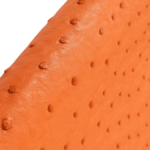Different Tanning Methods for Ostrich Leather

Ostrich leather has unique texture, strength, and durability. But do you know how ostrich leather is tanned? More precisely, what are the different tanning methods for ostrich leather?
This guide will introduce you to the most common tanning techniques used to transform raw ostrich skin into luxurious leather.
What Is Leather Tanning and Why Is It Important?
Why do we need to tan leather at all?
Tanning is the process that turns raw animal hides into usable leather. Without tanning, hides would decompose or become hard and brittle. Through tanning, leather becomes:
- Durable
- Flexible
- Resistant to moisture and rot
This is especially important for ostrich skin, which is naturally rich in oil and has a distinctive pattern that requires careful maintenance.
How to Tan Ostrich Leather: The Basics
So, how do you properly tan ostrich leather?
The process begins with cleaning and softening the raw hide. Different tanning methods are applied to the leather, depending on the color and tone.
Not every method works for ostrich. Because of its delicate pattern and natural oils, ostrich leather requires specialized techniques to preserve its appearance and texture.
The 2 Main Ostrich Leather Tanning Methods
Let’s explore the most common ostrich leather tanning methods used in the industry today.
1. Chrome Tanning
Chrome tanning is the most popular method for tanning ostrich leather, especially in the fashion and automotive industries.
How it works:
- They use chromium salts to tan the hide
- This method takes less time (1–3 days)
- Creates soft, flexible leather
- Great for vibrant colors and a smooth finish
Advantages:
- Excellent color absorption
- Water-resistant
- Cost-effective
- Fast production
Disadvantages:
- Less eco-friendly due to chemicals
- Not as firm as vegetable-tanned leather
Chrome tanning vs vegetable tanning ostrich leather often comes down to speed and color. Chrome wins if the goal is fashionable, colorful leather for bags, jackets, or car interiors.
2. Vegetable Tanning
Vegetable tanning is a traditional method using natural tannins from tree bark, leaves, and roots. This method is environmentally friendly.
How it works:
- They Soak the skin over weeks
- This method Enhances the natural grain and texture
- Vegetable tanning produces firmer, more structured leather
Advantages:
- Eco-friendly
- Long-lasting and ages beautifully
- Great for embossing and tooling
Disadvantages:
- Takes longer (3–6 weeks)
- Fewer color options
- Higher cost
This method is often used when sustainability or a classic, rustic look is preferred. Some buyers even feel that vegetable-tanned ostrich leather has a more luxurious “character” over time.
Chrome Tanning vs Vegetable Tanning Ostrich Leather: Which Is Better?
Comparison Table: Chrome Tanning vs. Vegetable Tanning for Ostrich Leather
| Feature / Criteria | Chrome Tanning | Vegetable Tanning |
|---|---|---|
| Main Materials Used | Chromium salts (chemical-based) | Natural tannins (plant-based) |
| Tanning Time | Fast (1–3 days) | Slow (3–6 weeks) |
| Color Variety | Wide range of vibrant, uniform colors | Limited, more natural tones |
| Flexibility & Softness | Very soft, supple finish | Firm and structured texture |
| Water Resistance | High | Moderate (can improve with treatment) |
| Aging / Patina | Less patina over time | Develops a rich, natural patina |
| Eco-Friendliness | Less eco-friendly (chemical waste) | Highly eco-friendly (biodegradable) |
| Durability Over Time | Stable but less structured | Extremely durable and tough |
| Cost | More cost-effective | Generally more expensive |
| Suitable For | Fashion goods, car interiors, upholstery | Belts, wallets, saddlery, handcrafted products |
| Embossing / Tooling | Not ideal for tooling | Perfect for embossing and detailed work |
| Sustainability Appeal | Lower | Higher (sustainable/ethical branding) |
Which Method Is Better for Your Application?
| Use Case / Product | Recommended Tanning Method |
|---|---|
| Fashion items (bags, shoes, jackets) | Chrome tanning – softer feel & color range |
| Luxury car interiors | Chrome tanning – smooth, flexible finish |
| Eco-conscious leather goods | Vegetable tanning – natural & sustainable |
| Handcrafted leather items | Vegetable tanning – ideal for tooling |
| Wallets & belts (long-lasting use) | Vegetable tanning – more durable |
| Mass production with fast turnaround | Chrome tanning – faster & more economical |
Are There Other Ostrich Leather Tanning Methods?
In addition to the two main methods, some tanneries use synthetic methods (using aldehydes) or mixed tanning (a combination of chrome and vegetable processes). They aim to achieve flexibility, strength, and environmental friendliness at the same time.However, such methods are less common.
Can You Tan Ostrich Leather at Home?
Technically, yes - but it's not recommended.
Ostrich skin is expensive and delicate. Tanning it incorrectly can cause discoloration, cracking, or loss of the leather's pattern. That's why professional factories - like those working under trusted names like LeatherBulk - use specialized equipment and trained experts to tan it.
Why Does the Tanning Method Matter When Buying Ostrich Leather?
Why is it essential for buyers to understand the tanning methods of ostrich leather:
- The type of tanning determines the durability and flexibility of the leather.
- It affects the price.
- It affects the final look and feel.
- It affects how the leather ages over time.
So the next time you buy ostrich leather, ask:
Was it chrome-tanned or vegetable-tanned?
Final Thoughts
Tanning is more than just a technical skill – it’s an art. And when you know how it’s done, you can make more informed choices and buy leather that’s right for your needs.
If you’re looking for high-quality ostrich leather that’s been carefully crafted, manufacturers like LeatherBulk are leading tanneries that use both methods, depending on the customer’s needs, and offer the best leather possible.
Al Quoz Industrial Area, United Arab Emirates




